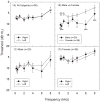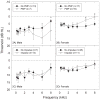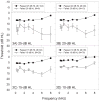Evidence of hearing loss in a 'normally-hearing' college-student population
- PMID: 21288064
- PMCID: PMC3095511
- DOI: 10.3109/14992027.2010.540722
Evidence of hearing loss in a 'normally-hearing' college-student population
Abstract
We report pure-tone hearing threshold findings in 56 college students. All subjects reported normal hearing during telephone interviews, yet not all subjects had normal sensitivity as defined by well-accepted criteria. At one or more test frequencies (0.25-8 kHz), 7% of ears had thresholds ≥25 dB HL and 12% had thresholds ≥20 dB HL. The proportion of ears with abnormal findings decreased when three-frequency pure-tone-averages were used. Low-frequency PTA hearing loss was detected in 2.7% of ears and high-frequency PTA hearing loss was detected in 7.1% of ears; however, there was little evidence for 'notched' audiograms. There was a statistically reliable relationship in which personal music player use was correlated with decreased hearing status in male subjects. Routine screening and education regarding hearing loss risk factors are critical as college students do not always self-identify early changes in hearing. Large-scale systematic investigations of college students' hearing status appear to be warranted; the current sample size was not adequate to precisely measure potential contributions of different sound sources to the elevated thresholds measured in some subjects.
Conflict of interest statement
The authors report no conflicts of interest. The authors alone are responsible for the content and writing of the paper. Support for this research was provided by an inter-institutional subcontract to the University of Florida, with funds from the National Institutes of Health via NIH/NIDCD U01 DC 008423 awarded to Josef Miller.
Figures



Similar articles
-
Headphone listening habits, hearing thresholds and listening levels in Swedish adolescents with severe to profound HL and adolescents with normal hearing.Int J Audiol. 2018 Oct;57(10):730-736. doi: 10.1080/14992027.2018.1461938. Epub 2018 Apr 27. Int J Audiol. 2018. PMID: 29703094
-
Otitis media with effusion in children: Cross-frequency correlation in pure tone audiometry.PLoS One. 2019 Aug 22;14(8):e0221405. doi: 10.1371/journal.pone.0221405. eCollection 2019. PLoS One. 2019. PMID: 31437206 Free PMC article.
-
Assessing Agreement between Frequency-Specific Chirp Auditory Steady-State Response and Pure Tone Audiometry in Adults by Intraclass Correlation Coefficient.ORL J Otorhinolaryngol Relat Spec. 2022;84(1):30-38. doi: 10.1159/000515237. Epub 2021 May 12. ORL J Otorhinolaryngol Relat Spec. 2022. PMID: 33979798
-
Extended high-frequency thresholds in college students: effects of music player use and other recreational noise.J Am Acad Audiol. 2013 Sep;24(8):725-39. doi: 10.3766/jaaa.24.8.9. J Am Acad Audiol. 2013. PMID: 24131608 Free PMC article.
-
No Reliable Association Between Recreational Noise Exposure and Threshold Sensitivity, Distortion Product Otoacoustic Emission Amplitude, or Word-in-Noise Performance in a College Student Population.Ear Hear. 2018 Nov/Dec;39(6):1057-1074. doi: 10.1097/AUD.0000000000000575. Ear Hear. 2018. PMID: 29543608
Cited by
-
Epidemiology and Risk Factors for Hearing Damage Among Adults Using Headphones via Mobile Applications.Cureus. 2022 May 31;14(5):e25532. doi: 10.7759/cureus.25532. eCollection 2022 May. Cureus. 2022. PMID: 35800830 Free PMC article.
-
Differences in Hearing Acuity among "Normal-Hearing" Young Adults Modulate the Neural Basis for Speech Comprehension.eNeuro. 2018 Jun 8;5(3):ENEURO.0263-17.2018. doi: 10.1523/ENEURO.0263-17.2018. eCollection 2018 May-Jun. eNeuro. 2018. PMID: 29911176 Free PMC article.
-
The audiogram: Detection of pure-tone stimuli in ototoxicity monitoring and assessments of investigational medicines for the inner ear.J Acoust Soc Am. 2022 Jul;152(1):470. doi: 10.1121/10.0011739. J Acoust Soc Am. 2022. PMID: 35931504 Free PMC article. Review.
-
The hidden effect of hearing acuity on speech recall, and compensatory effects of self-paced listening.Int J Audiol. 2012 Aug;51(8):576-83. doi: 10.3109/14992027.2012.684403. Epub 2012 Jun 26. Int J Audiol. 2012. PMID: 22731919 Free PMC article.
-
Comprehensive Audiometric Analysis of Hearing Impairment and Tinnitus After Cisplatin-Based Chemotherapy in Survivors of Adult-Onset Cancer.J Clin Oncol. 2016 Aug 10;34(23):2712-20. doi: 10.1200/JCO.2016.66.8822. Epub 2016 Jun 27. J Clin Oncol. 2016. PMID: 27354478 Free PMC article.
References
-
- Agrawal Y, Platz EA, Niparko JK. Prevalence of hearing loss and differences by demographic characteristics among US adults: data from the National Health and Nutrition Examination Survey, 1999–2004. Arch Intern Med. 2008;168:1522–1530. - PubMed
-
- Agrawal Y, Platz EA, Niparko JK. Risk factors for hearing loss in US adults: data from the National Health and Nutrition Examination Survey, 1999 to 2002. Otol Neurotol. 2009;30:139–145. - PubMed
-
- American National Standards Institute. Specifications for audiometers, S3.6–1969. American National Standards Institute; New York: 1969.
-
- American Standards Association. American standard specification for audiometers for general diagnostic purposes, Z24.5–1951. New York: ANSI; 1951.
-
- Barrenas ML, Hellstrom PA. The effect of low level acoustic stimulation on susceptibility to noise in blue- and brown-eyed young human subjects. Ear Hear. 1996;17:63–68. - PubMed
Publication types
MeSH terms
Grants and funding
LinkOut - more resources
Full Text Sources
Other Literature Sources
Medical
Miscellaneous
